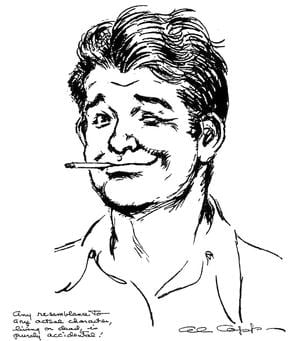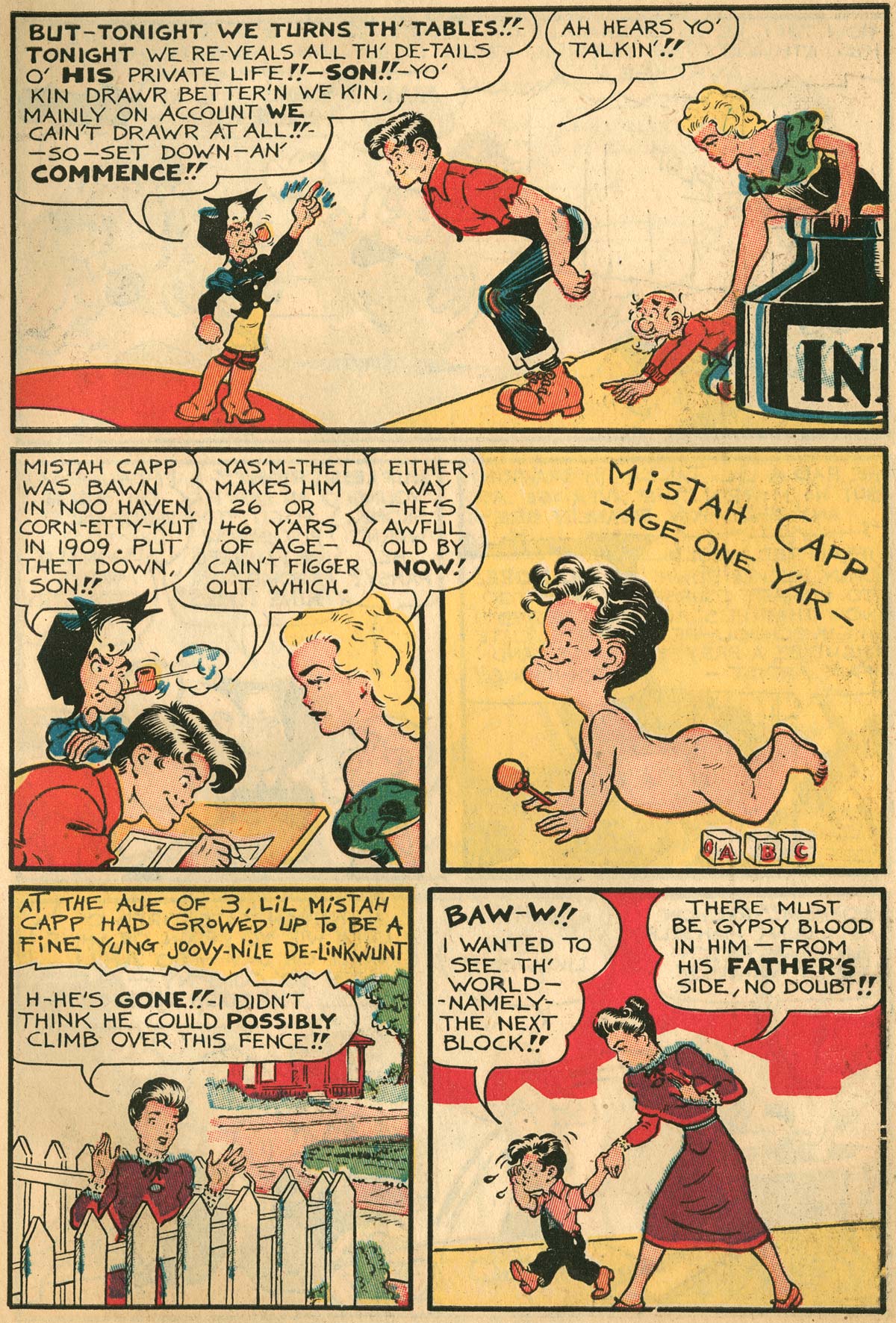
As both a character and as a brand, Li’l Abner is a standout. Al Capp’s best-known creation hit the newsstands in August of 1934 and enjoyed 43 years of ongoing publication. Sensibilities in the ’30s were significantly different than those of today. The use of stereotypes and caricature were commonplace, especially in comic strips and on the pages of pulp magazines. Nowadays, Capp’s representation of simple southern folk living complicated southern lives might be met with hostility by some. After all, what right did Al Capp, a New Yorker born in Connecticut, have to parody life in the south?
Right or wrong, readers devoured Capp’s tales of life in Dogpatch, USA. In its heyday, Li’l Abner boasted a readership that numbered in the millions, and, after reading the first year, I can safely say that, anachronistic political incorrectness aside, I understand why.
Meet the Yokums: Great Grandaddy Yokum – Al Capp
Li’l Abner vs. Streetcar
Before diving into Dogpatch, the pastoral southern paradise that is home to the Yokum family, the uninitiated should probably learn a few things about Li’l Abner‘s creator, Al Capp, born Alfred G. Caplin. Capp led a full and controversial life peppered with staggering wins and losses. Creating Li’l Abner, a one-of-a-kind comic-strip franchise that spawned several successful adaptations including two major motion pictures, was probably Capp’s biggest win. His biggest loss, an event which changed his life forever, happened at nine years old when a streetcar ran over Capp’s left leg.
To prevent the spread of gangrene, doctors amputated Capp’s leg well above his knee. Though the young Connecticuter survived and eventually learned to walk using a prosthetic wooden leg, the prosthesis was unreliable and very difficult to master. Continual discomfort and periodic breakdowns of his prosthesis made Capp’s life difficult, but the underlying embarrassment about his injury caused Capp significant stress as well.

Al Capp, Celebrity at Large
A hardy individual, though, Capp proved that tenacity, talent, and a bit of luck can go a long way. Capp made his name not only as one of the last celebrity cartoonists but also as a TV-and-radio personality who frequently appeared on The Tonight Show, so much in fact that Capp appeared on shows hosted by Steve Allen, Jack Paar, and Johnny Carson!
Li’l Abner, Political Pundit
Although in the early years Capp used Li’l Abner as a means to lampoon stuffed-shirt conservatives, whether from the north or the south, as the character and Capp aged Li’l Abner developed a decidedly more conservative tone.

Capp came down on what many would consider the wrong side of history on a number of landmark political issues, including in his support for the war in Vietnam. Where many other artists and intellectuals protested the war, Capp protested the protestors, taking issue with what he considered un-American actions of anti-war demonstrators and hippies. One such jab was Capp’s insertion of the student group SWINE (Students Wildly Indignant about Nearly Everything) into Li’l Abner, a parody of the very real Youth International Party (YIP) and Students for a Democratic Society (SDS).
Not Quite Enough Southern Charm
Claims of sexual misconduct by a variety of women, including Goldie Hawn and Grace Kelly, act as reprehensible low-points in this entertainer’s full and astonishing life. One wonders what Li’l Abner or Mammy Yokum would’ve had to say about Capp allegedly exposing himself to four female University of Alabama students in 1971 or his being charged with indecent exposure, attempted adultery, and sodomy by a University of Wisconsin-Eau Claire student in 1972.

Meet the Yokums: Li’l Abner’s Al Capp
Rather than go into too much detail on these and other parts of Capp’s life, I’ll refer interested readers to Capp’s comic-strip “autobiography.” One of the best bits of bonus material in IDW‘s collection Al Capp’s Li’l Abner, The Complete Dailies and Color Sundays Volume One: 1934–1936 is Capp’s sequential art autobiography, written as if Li’l Abner is writing, drawing, and inking the strip instead.
Capp’s autobiographical strip covers pivotal moments in the cartoonist’s life, including the amputation of his leg, his recovery from his amputation, meeting his wife, the birth of his children, and his struggle and eventual success in his professional life.
Though this account is romanticized, it acts as a good indication of what Capp saw as the formative moments of his life, and, though it glosses over some ugly moments in true Capp fashion the moral of the story is that you can’t keep a good man down.
Meet the Yokums: Next Up, The Yokums
Now that the uninitiated have some idea of what Li’l Abner‘s creator was all about, it’s time to get on with introducing Capp’s creations, the constituents of Dogpatch. Check out my article on Li’l Abner‘s titular character and the rest of the Yokum family.

